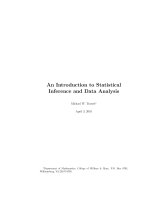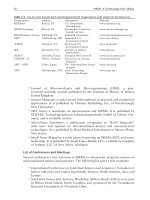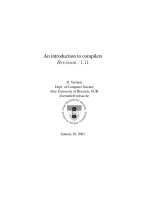An introduction to PCR
Bạn đang xem bản rút gọn của tài liệu. Xem và tải ngay bản đầy đủ của tài liệu tại đây (233.29 KB, 8 trang )
An introduction to PCR
1.1 Introduction: PCR, a ‘DNA photocopier’
Does it really work? It is so simple! Why did I not think of it? These
thoughts were probably typical of most molecular biologists on reading
early reports of the polymerase chain reaction or PCR as it is more
commonly called. PCR uses a few basic everyday molecular biology reagents
to make large numbers of copies of a specific DNA fragment in a test-tube.
PCR has been called a ‘DNA photocopier’. While the concept is simple, PCR
is a complicated process with many reactants. The concentration of
template DNA is initially very low but its concentration increases dramatic-
ally as the reaction proceeds and the product molecules become new
templates. Other reactants, such as dNTPs and primers, are at concentra-
tions that hardly change during the reaction, while some reactants, such
as DNA polymerase, can become limiting. There are significant changes in
temperature and pH and therefore dramatic fluctuations in the dynamics
of a range of molecular interactions. So, PCR is really a very complex
process, but one with tremendous power and versatility for DNA manipu-
lation and analysis.
In the relatively short time since its invention by Kary Mullis, PCR has
revolutionized our approach to molecular biology. The impact of PCR on
biological and medical research has been like a supercharger in an engine,
dramatically speeding the rate of progress of the study of genes and
genomes. Using PCR we can now isolate essentially any gene from any
organism. It has become a cornerstone of genome sequencing projects, used
both for determining DNA sequence data and for the subsequent study of
putative genes and their products by high throughput screening method-
ologies. Having isolated a target gene we can use PCR to tailor its sequence
to allow cloning or mutagenesis or we can establish diagnostic tests to
detect mutant forms of the gene. PCR has become a routine laboratory tech-
nique whose apparent simplicity and ease of use has allowed nonmolecular
biology labs to access the power of molecular biology. There are many
scientific papers describing new applications or new methods of PCR. Many
commercial products and kits have been launched for PCR applications in
research and for PCR-based diagnostics and some of these will be discussed
in later chapters.
1.2 PCR involves DNA synthesis
PCR copies DNA in the test-tube and uses the basic elements of the natural
DNA synthesis and replication processes. In a living cell a highly complex
system involving many different proteins is necessary to replicate the
complete genome. In simplistic terms, the DNA is unwound and each
strand of the parent molecule is used as a template to produce a comple-
1
mentary ‘daughter’ strand. This copying relies on the ability of nucleotides
to base pair according to the well-known Watson and Crick rules; A always
pairs with T and G always pairs with C. The template strand therefore
specifies the base sequence of the new complementary DNA strand. A large
number of proteins and other molecules, such as RNA primers, are required
to ensure that the process of DNA replication occurs efficiently with high
fidelity, which means with few mistakes, and in a tightly regulated manner.
DNA synthesis by a DNA polymerase must be ‘primed’, meaning we need
to supply a short DNA sequence called a primer that is complementary to
a template sequence. Primers are synthetically produced DNA sequences
usually around 20 nucleotides long. The DNA polymerase will add
nucleotides to the free 3′-OH of this primer according to the normal base
pairing rules (Figure 1.1).
2 PCR
Primer
DNA
polymerase
Template
Synthesis of new DNA strand
5' 3'
3'
5'
5'
dNTPs
T
G
T
T
C
C
C
A
A
G
G
A
T
T
T
G
G
GGA
A
A
C
C
CC
3'
3'
5'
5'
3'
AAA
AA
GG
G
TT
TTTCC
C
Figure 1.1
Primer extension by a DNA polymerase. The primer anneals to a complementary
sequence on the template strand and the DNA polymerase uses the template
sequence to extend the primer by incorporation of the correct deoxynucleotide
(dNTP) according to base pairing rules.
PCR requires only some of the components of the complex replication
machinery to copy short fragments of DNA in a simple buffer system in a
test tube. Unwinding of the DNA in the cell uses a multi-component
complex involving a variety of enzymes and proteins, but in PCR this is
replaced simply by a heating step to break the hydrogen bonds between
the base pairs of the DNA duplex, a process called denaturation.
Following template denaturation two sequence-specific oligonucleotide
primers bind to their complementary sequences on the template DNA
strands according to normal base pairing rules (Figure 1.2). These primers
define the region of template to be copied. DNA polymerase then begins
to add deoxynucleotides to the 3′-OH group of both primers producing new
duplex DNA molecules (Figure 1.2). This requirement of DNA polymerases
to use primers to initiate DNA synthesis is critical for the PCR process since
it means we can control where the primers bind, and therefore which
region of DNA will be replicated and amplified. If the DNA polymerase was
like an RNA polymerase that does not require a primer then we would have
no way of defining what segment of DNA we wanted to be copied.
At the next heating step the double-stranded molecules, which are
heteroduplexes containing an original template DNA strand and a newly
synthesized DNA strand produced during the first DNA synthesis reaction,
are now denatured. Each DNA single strand can now act as a template for
the next round of DNA synthesis. As discussed in detail in Chapter 2, it is
during this second cycle of PCR that the first DNA single strand of a length
defined by the positions of the primers can be formed. In cycle 3 the first
correct length double-stranded PCR products are formed. In subsequent
cycles there is then an exponential increase in the number of copies of the
‘target’ DNA sequence; theoretically, the number of copies of the target
sequence will be doubled at each PCR cycle. This means that at 100%
efficiency, each template present at the start of the reaction would give rise
to 10
6
new strands after only 20 cycles of PCR. Of course the process is not
100% efficient, and it is usually necessary to carry out more reaction cycles,
often 25 to 40 depending upon the concentration of the initial template
DNA, its purity, the precise conditions and the application for which you
require the product. The specificity and efficiency of PCR, however, means
that very low numbers of template molecules present at the start of the PCR
can be amplified into a large amount of product DNA, often a microgram
or more, which is plenty for a range of detailed analyses. Of course, this
ability to amplify also means that if you happen to contaminate your
reaction with a few molecules of product DNA from a previous reaction, you
may get a false result. This is why performing control reactions is so impor-
tant and we will deal with such contamination problems in Chapter 4.
1.3 PCR is controlled by heating and cooling
PCR relies on the use of different temperatures for the three steps of the
reaction, denaturation, annealing and extension. A high temperature,
usually 94–95°C, is used to denature (separate) the strands of the DNA
template. The temperature is then lowered to allow the primers to anneal
by base pairing to their complementary sequences on the template strands;
this temperature varies depending on the primers (see details in Chapter 3).
An introduction to PCR 3
The annealing temperature is important to ensure high specificity in the
reaction; generally the higher the annealing temperature the more specific
will be the reaction. A temperature of 55°C is commonly used, but in many
cases a higher temperature is better and this can even be as high as 72°C
for some experiments, leading to a two-temperature PCR cycle. Finally, for
4 PCR
G
5'
5'
5'
3'
3'
3'
3'
3'
5'
5'
5' 3'
3'
5'
3'
Primer 2
dNTPs
Primer 1
Synthesis of new DNA strands defined by primers
T
T
T
G
G
G
A
AA
A
A
CC
C
C
C
CC
CC CC
CC CC
CC CC
CC CC
AA
AAA
AA A
A
AAAA
AAA
G
GG
GG GG
GG G
GG GG
GG GG
TT T
TT T
TTT
TT
TTTT
5'
TTG
A
C
5' 3'
3' 5'
DNA denatured and
primers annealed
TT
TTTT
GG
GG GG
C
CCCAA AC
TGGCCCAA AA
Figure 1.2
The first cycle of a PCR. A double-stranded template molecule is denatured.
Primers anneal to their complementary sequences on the single-stranded
template. DNA synthesis is catalyzed by a thermostable DNA polymerase. The
result of this PCR cycle is that two copies of the target sequence have been
generated for each original copy.
efficient DNA synthesis, the temperature is adjusted to be optimal for the
DNA polymerase activity, normally 72°C (see Chapter 3). To amplify the
target DNA it is necessary to cycle through these temperatures several times
(25 to 40 depending on the application). Conveniently, this temperature
cycling is accomplished by using a thermal cycler, a programmable instru-
ment that can rapidly alter temperature and hold samples at the desired
temperature for a set time. This automation is one of the important
advances that led to PCR becoming widely accessible to many scientists and
is covered in more detail in Chapter 3. Before thermal cyclers became avail-
able, PCR was performed by using three water baths set to temperatures of
typically 95°C, 55°C and 72°C, and reaction tubes in racks were moved
manually between the baths.
The other major technological advance that preceded the development
of thermal cyclers was the replacement of DNA polymerase I Klenow
fragment with thermostable DNA polymerases, such as Taq DNA poly-
merase, which are not inactivated at the high denaturation temperatures
used during PCR. The ability to carry out the reaction at high temperatures
enhances the specificity of the reaction (Chapter 4). At 37°C, where
Klenow works best, primers can bind to nontarget sequences with weak
sequence similarity, because mismatches between the two strands can be
tolerated. This leads to poor specificity of primer annealing and the amplifi-
cation of many nontarget products. The introduction of thermostable DNA
polymerases also reduced the cost of a reaction by reducing the amount of
polymerase required. With Klenow, at each denaturing step the enzyme
was also denatured and therefore a fresh aliquot had to be added at each
cycle. Thermostable polymerases retain their activity at the denaturation
temperatures and therefore only need to be added at the start of the
reaction.
1.4 PCR applications and gene cloning
PCR has revolutionized our approach to basic scientific and medical
research, to medical, forensic and environmental testing. It provides an
extremely flexible tool for the research scientist, and every molecular
biology research laboratory now uses PCR routinely; often adapting and
tailoring the basic procedures to meet their own special needs. It has
become an indispensable tool for routine and repetitive DNA analyses such
as diagnosis of certain genetic diseases within clinical screening laboratories
where speed and accuracy are important factors, and also for sample
identification in forensic and environmental testing. In particular PCR has
become a central tool in the analysis and exploitation of genome sequence
information, for example in gene knockout through RNA interference
where PCR allows the rapid generation of appropriate constructs. It also
facilitates measurement of levels of gene expression by ‘real-time’ PCR that
monitors the level of product amplification at each cycle of the PCR
(Chapter 9), providing information on the relative concentrations of
template cDNA.
In some cases PCR provides an alternative to gene cloning, but in other
cases it provides a complementary tool. In gene cloning a fragment of DNA
is joined by ligation to a cloning vector which is able to replicate within a
An introduction to PCR 5









